It's nearly a meter long and engraved with 100 green dragons. It's double edged, sharp at the tip and can cut through iron as if it were mud. It's the legendary Green Destiny Sword (
But few know that the birthplace of this exquisite sword is a fishing village in Kaohsiung County, Taiwan. Kuo Chang-shi (
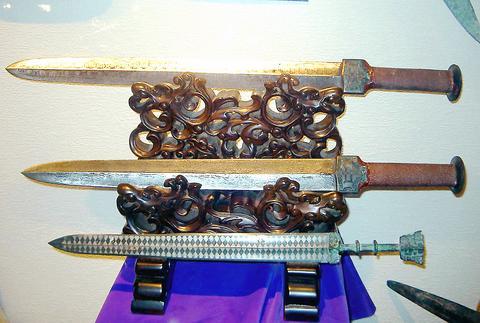
PHOTO: YU SEN-LUN, TAIPEI TIMES
Besides Green Destiny, he has made nearly 400 swords, machetes and spears, such as the double-edged curved ax (
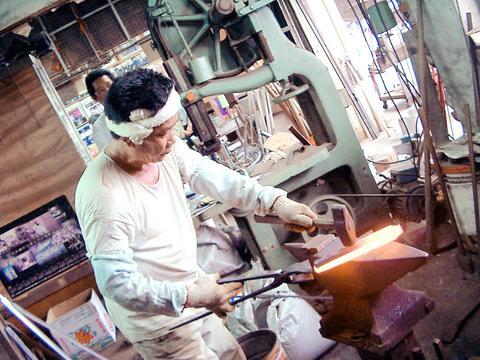
PHOTO: YU SEN-LUN, TAIPEI TIMES
Kuo is not just a maker of film props. He is the owner of Shin Da Arts Sword Store (興達刀舖) and a collector of swords and knives. His Kuo Chang-shi Arts Swords Museum (郭常喜藝術兵器文物館) opened early this year.
Kuo's neighbors from the small fishing of Shin Da call him master Ah-shi (
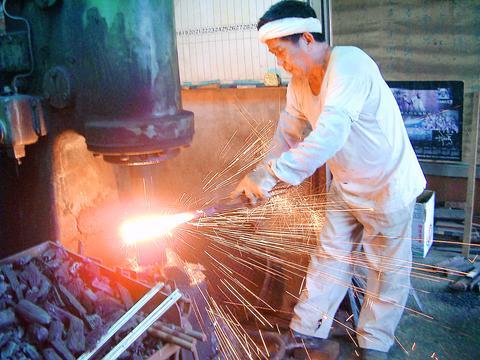
PHOTO: YU SEN-LUN, TAIPEI TIMES
A third-generation blacksmith, Kuo learnt his skills at the age of 13. Now that he's 47 years old, he's still the only full-time worker at his sword-making factory. Every day he works by the forge sweating in the 700°C temperatures. Kuo said a good sword should be forged over 100 times, sometimes in temperatures as high as 1300°C.
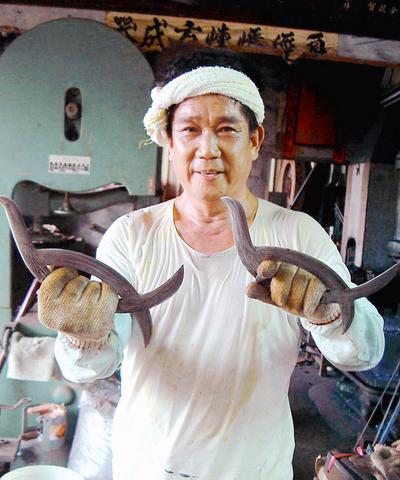
PHOTO: YU SEN-LUN, TAIPEI TIMES
After taking up his father's blacksmith shop in his 20s, Kuo soon became famous in south Taiwan for his knife-making skills. He is one of the few workers who is able to produce full sets of Taoist traditional weapons used in local temple
ceremonies.
His love of ancient swords and knives then prompted him to go to Japan for eight years and learn sword making, especially the multiple-layered steel wrapping technique that he developed and which dates back to the Warring States period (403 to 221BC.). The blacksmith first prepares eight layers of steel and iron, with the steel inside and iron outside (as iron is softer than steel). Then the eight layers are folded together to become a bar. Then it is folded again to create 16 layers, then 32, then 64, and so on up to a 1,000 layers. Kuo said swords or knives made in this way are strong yet supple and cut like a razor. To prove it, he chopped a 5cm-thick steel rope in half and one of the pieces flew out the side of the house.
It takes strength, perseverance and devotion to become a sword maker and Kuo delights in talking about the stories of Gan-jiang (
A king from the Wu state ordered the couple to make two superior swords in three months. But limited by technique, the two found it hard to forge pure steel. In desperation, Mo, the wife, then threw herself into the forge.
As human bones can filter out impurities from iron and steel great swords were eventually made. And the swords were named after the couple. "That was the first sword made with a steel-wrapping technique in history," Kuo said.
Kuo said he had been collecting swords for over 40 years and boasted the newly opened Kuo Chang-shi Art Swords Museum now has more than 1,0000 ancient swords and knives. Kuo has also reproduced some of the ancient swords that had been lost. About 80 percent of the swords in the museum were re-created by Kuo, including the Green Destiny. There are also Japanese samurai swords and swords used by Taiwanese Aboriginals.
Making a Green Destiny sword takes about two days, Kuo said, and costs around NT$100,000 -- but this price has not deterred politicians and celebrities from coveting the sword.
Having been a blacksmith and having finally owned a museum of his own, Kuo's only unfulfilled goal is to find a disciple to pass down all his skills and techniques.
"None of my kids wants to work under the heat," he said. "Besides, sword making takes superb skills and it is hard to find young people who not only can endure the heat and are hard-working, but also have skillful hands," he said.
"I once trained a young man for four years but all he could make was a fine farming tool. So he gave up," Kuo said.

Many people noticed the flood of pro-China propaganda across a number of venues in recent weeks that looks like a coordinated assault on US Taiwan policy. It does look like an effort intended to influence the US before the meeting between US President Donald Trump and Chinese dictator Xi Jinping (習近平) over the weekend. Jennifer Kavanagh’s piece in the New York Times in September appears to be the opening strike of the current campaign. She followed up last week in the Lowy Interpreter, blaming the US for causing the PRC to escalate in the Philippines and Taiwan, saying that as
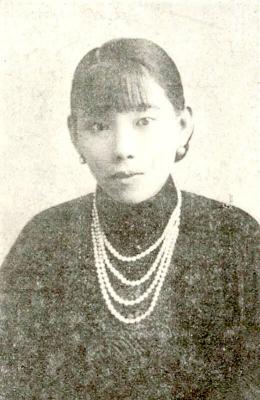
Nov. 3 to Nov. 9 In 1925, 18-year-old Huang Chin-chuan (黃金川) penned the following words: “When will the day of women’s equal rights arrive, so that my talents won’t drift away in the eastern stream?” These were the closing lines to her poem “Female Student” (女學生), which expressed her unwillingness to be confined to traditional female roles and her desire to study and explore the world. Born to a wealthy family on Nov. 5, 1907, Huang was able to study in Japan — a rare privilege for women in her time — and even made a name for herself in the

This year’s Miss Universe in Thailand has been marred by ugly drama, with allegations of an insult to a beauty queen’s intellect, a walkout by pageant contestants and a tearful tantrum by the host. More than 120 women from across the world have gathered in Thailand, vying to be crowned Miss Universe in a contest considered one of the “big four” of global beauty pageants. But the runup has been dominated by the off-stage antics of the coiffed contestants and their Thai hosts, escalating into a feminist firestorm drawing the attention of Mexico’s president. On Tuesday, Mexican delegate Fatima Bosch staged a

Taiwan can often feel woefully behind on global trends, from fashion to food, and influences can sometimes feel like the last on the metaphorical bandwagon. In the West, suddenly every burger is being smashed and honey has become “hot” and we’re all drinking orange wine. But it took a good while for a smash burger in Taipei to come across my radar. For the uninitiated, a smash burger is, well, a normal burger patty but smashed flat. Originally, I didn’t understand. Surely the best part of a burger is the thick patty with all the juiciness of the beef, the